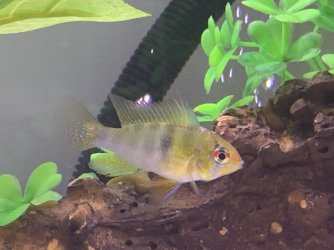Hi all,
I'm currently seeing some strange/concerning behaviour from my Synodontis Petricola and I'm struggling to find much information about them online!
They have been fine up until last week when I purchased 2 German Blue Rams. I noticed that the female Ram had the very early stages of Finrot so I treated with interpet anti finrot treatment. After a few hours all of the fish in the tank were gasping at the surface so I added in an extra line of air which helped. Since then though my Synodontis Petricola have been acting very strange. They are flashing regularly and alarmingly. Swimming very erratically and or swimming up and down one side of the tank or in one place constantly. This is very unusual as they usually spend most of their time hiding unless feeding or the aquarium light is off.
Yesterday it reached a head and 4 days in to the treatment I decided this wasn't worth it anymore as I feared losing the catfish. I did a 40% water change and reintroduced carbon to the filter to remove the medication. This has helped but one fish in particular is still flashing and or swimming in one place up and down the glass. He has no sign of ich or anything visible at all.
Water is PH 7.4/6 which is steady. 0 ammonia and nitrite, nitrate about 15pp I would say.
I do weekly water changes of 40% and I'm religious with testing my water.
I have an 100l tank with a fluval 106. The tank has been established about 3 months and is well cycled.
The medicine did throw the cycle and I had a nitrite spike which I sorted very quickly with Prime.
I am at a loss as to what is wrong with the catfish? There are no visible signs of anything bacteria/parasite and they are still eating but they're clearly not happy about something.
My tank is over stocked as my molly's gave birth and 4 have grown (so now have 8). The other babies were eaten unfortunately as the mother gave birth before I could get a net for them. I have found a new home for the babies and they will be going this weekend. Could it be this that's stressing them out?
Any thoughts or insights are greatly appreciated! I am a complete novice with synodontis!
Thanks!
Harry
I'm currently seeing some strange/concerning behaviour from my Synodontis Petricola and I'm struggling to find much information about them online!
They have been fine up until last week when I purchased 2 German Blue Rams. I noticed that the female Ram had the very early stages of Finrot so I treated with interpet anti finrot treatment. After a few hours all of the fish in the tank were gasping at the surface so I added in an extra line of air which helped. Since then though my Synodontis Petricola have been acting very strange. They are flashing regularly and alarmingly. Swimming very erratically and or swimming up and down one side of the tank or in one place constantly. This is very unusual as they usually spend most of their time hiding unless feeding or the aquarium light is off.
Yesterday it reached a head and 4 days in to the treatment I decided this wasn't worth it anymore as I feared losing the catfish. I did a 40% water change and reintroduced carbon to the filter to remove the medication. This has helped but one fish in particular is still flashing and or swimming in one place up and down the glass. He has no sign of ich or anything visible at all.
Water is PH 7.4/6 which is steady. 0 ammonia and nitrite, nitrate about 15pp I would say.
I do weekly water changes of 40% and I'm religious with testing my water.
I have an 100l tank with a fluval 106. The tank has been established about 3 months and is well cycled.
The medicine did throw the cycle and I had a nitrite spike which I sorted very quickly with Prime.
I am at a loss as to what is wrong with the catfish? There are no visible signs of anything bacteria/parasite and they are still eating but they're clearly not happy about something.
My tank is over stocked as my molly's gave birth and 4 have grown (so now have 8). The other babies were eaten unfortunately as the mother gave birth before I could get a net for them. I have found a new home for the babies and they will be going this weekend. Could it be this that's stressing them out?
Any thoughts or insights are greatly appreciated! I am a complete novice with synodontis!
Thanks!
Harry




